Pregnancy is a beautiful and life-changing experience, but it also alters a woman’s body in the process for better or for worse. This is why so much emphasis is placed on postpartum recovery, and postnatal exercise is a vital part of it. It’s not so much about looking better but feeling better, as postnatal exercise is meant to help a new mother regain her fitness to better care for her child.
Malaysian pregnancy fitness instructor Karen Siah knows all about that life. She’s had two kids, and bounced back both times stronger and better. Drawing from her own experiences and researched knowledge, she now helps aspiring ladies achieve their postnatal fitness goals. We caught up with Karen to ask her all of your burning questions on postpartum exercise, plus five essential workouts that you can try at home.
Note: The following interview has been edited for clarity and brevity.
Everything About Postnatal Exercise and Motherhood-Life Balance

Your Instagram bio says: Athlete. Mother. Runner. Triathlete. How do you balance it all? Has motherhood changed your workout routine at all?
Yes, very much! I don’t have as much time now, so I try to work out a schedule with my husband, where we take turns every weekend to get our big workouts in. During the week, I try to sneak in little workout sessions in between with my personal training (PT) clients while the kids are at daycare.
How motivated were you to get back to working out after your delivery?
I was very motivated to get back into shape! Especially now that we’re transitioning into a post-pandemic state and race events are making a comeback, I’m very driven to train to compete again.
With two kids in the picture, how do you find time to squeeze in exercise?
This is definitely a challenge, and the support of your spouse or support circle (relatives who can help with babysitting) is crucial. Every family is different, and every stage of a child’s development is also different. So it’s about trying to find time and learning to prioritise what’s important. Daddies must also jump on this bandwagon and encourage mummies to have some personal time where possible, as a healthy mum is a more effective mum.
So what’s the difference between regular workout and postnatal exercise?
Apart from starting slow and regaining fitness after a period of rest and recovery, postnatal exercise also focuses on deep core muscles and pelvic floor strength so we can avoid or treat postpartum issues like diastasis recti (separation of the abs due to pregnancy) and incontinence (accidentally peeing when coughing, sneezing, jumping, or running).
Why is postnatal exercise so important after giving birth to a child?
From a physical standpoint, postnatal exercise gives a mother some strength in her muscles, and reduces back and neck pain from carrying babies, breastfeeding, and changing diapers.
From a mental standpoint, it provides a mother with some me-time, as caring for a newborn can be pretty demanding and time consuming, and she can feel like she has lost her own identity.
How soon after a natural birth or C-section can a new mum start doing postnatal exercises?
For natural birth, I recommend six weeks and above. Once the wound (if there are any stitches) has healed, she can start exercising.
For C-section birth, I recommend three months and above. It’s different for everyone, but it does take much longer for a mum to recover from surgery.
Can you share some safety tips for mums who would like to take up postpartum exercises?
Advance gradually, and don’t push yourself too hard too fast. If possible, work with a certified trainer. We are professionals who can help you achieve your fitness goals safely. Otherwise, do research on the issues of diastasis recti and pelvic floor weakness before proceeding.
What kind of workouts should they avoid?
No crunches and torso rotations (Russian twists, bicycle exercises) for about six to nine months, as this causes or worsens diastasis recti. Learning to re-engage the deep core muscles is something that I am trained to help a postpartum mum with.

Apart from exercise, are there any other practices that postpartum women should observe to aid their recovery?
A nutritious, and balanced diet, with lots of protein and plenty of hydration is good. Postpartum nutrition varies from culture to culture, but generally the key is to eat well and rest well. Just as you would if you were recovering from an illness or injury. Rest is just as important as food.
Before we dive into postpartum exercises, do you have any final words of advice for ladies who are new to the motherhood club?
Take it one day at a time. Motherhood is a journey, like a marathon, and there’s no rush to return to being fit like in your pre-pregnancy days. Live and experience every moment of every day!
Essential Postnatal Exercises For New Mums
Below, Karen takes us through five of the best postnatal exercises to help new mums regain fitness and strength. Don’t fret if you can’t manage all of them. Just start with any three exercises that you’re comfortable with. If you’re affected by diastasis recti, Karen recommends using a stretchy exercise waist band during your workouts to limit movements.
Glute Bridge
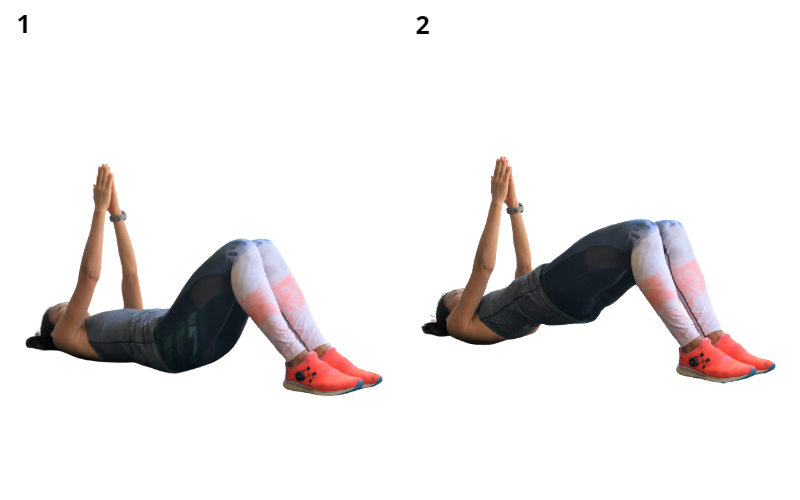
Benefit: Strengthens pelvic floor muscles and deep core muscles
Technique: Lie on your back on a yoga mat, with your knees bent in a 90-degree angle and arms raised. Squeeze your glute muscles and lift your hips up, then gently lower your hips down.
Reps: Three sets of 12
Modified Leg Raises
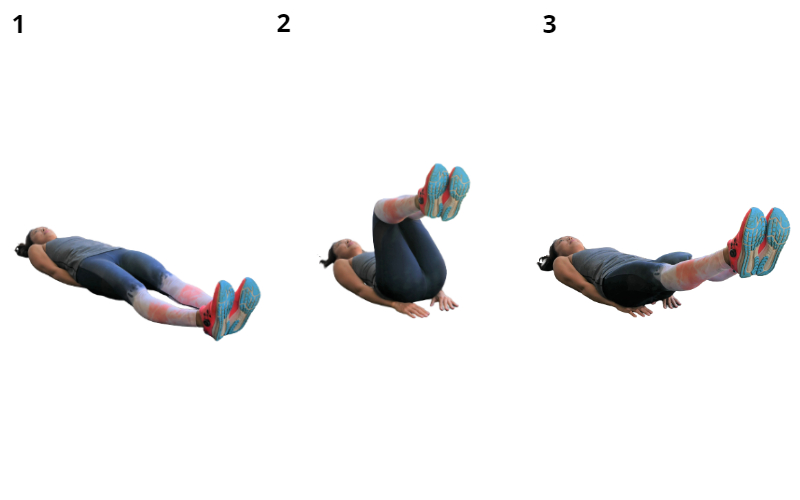
Benefit: Re-engages the deep core muscles
Technique: Lie on your back and place your hands under your hips. Hold your belly button in to engage your core. Then lift your feet off the ground with knees bent in a 90-degree angle. Slowly straighten out your legs then pull them back.
Reps: Three sets of 12
Flutter Kicks
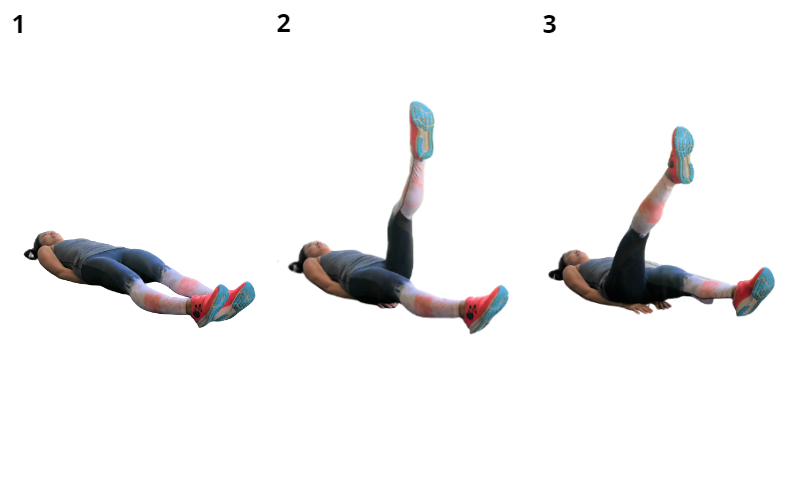
Benefit: Re-engages the deep core muscles
Technique: Lie on your back and place your hands under your hips. Hold your belly button in to engage your core. Then move your legs up and down alternately, in a scissors fashion.
Modified: Rather than lying down with your legs straight, bend your knees in a 90-degree angle then straighten out one leg at a time alternately – almost like cycling.
Reps: Three sets of 12
Sumo Squats
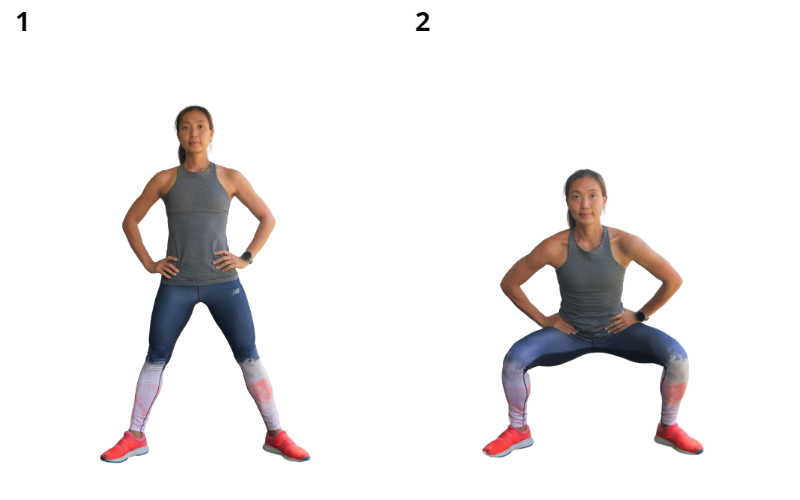
Benefit: Improves glutes and lower body strength
Technique: Stand with your feet wider than hip-width apart. Rest your hands on your hips and point your toes 45 degrees outwards. Squat down until your knees are bent in a 90-degree angle, then slowly stand back up.
Reps: Three sets of 12
Shoulder Press And Triceps Extension Combo

Benefit: Strengthens shoulder and triceps strength
Technique: Standing up, hold a weight of up to 5kg (or more) with both hands in front of your chest. Push the weight up above your head, then bend your elbows to lower the weight behind your head. Raise your arms back up again, then lower the weight down to chest level.
Reps: Three sets of 12
Regain Your Fitness After Birth With These Simple Postnatal Exercises
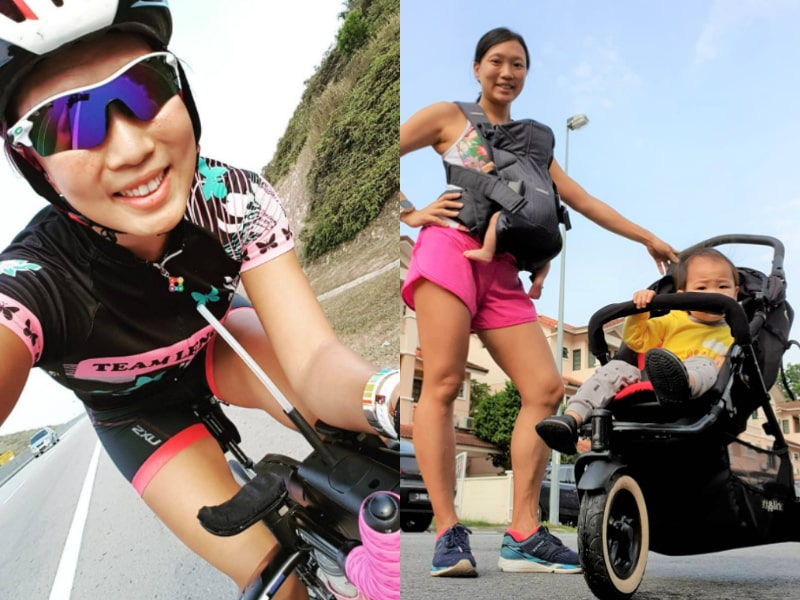
Self-care is truly the best care after all the hard work of birthing a child. So if you can, try to put yourself first from time to time. Along with rebuilding your health, postnatal exercise can help carve out some much-needed alone time. Of course, always seek your doctor’s opinion before beginning any postpartum exercise and start at your own pace. You got this!
If you’d like to prep yourself for your next pregnancy, check out Karen’s advice on prenatal exercises. For enquiries on PT services, feel free to drop Karen a DM on her socials.
Instagram: @karensiahfitnesscoach
Facebook: Karen Siah Fitness Coach
